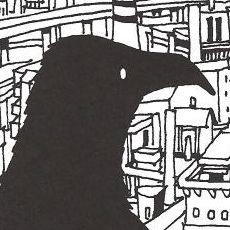Tag: science fiction
-
Night Head Genesis – Psychic bishounen, brotherly love
/
/ ReviewsRead More →: Night Head Genesis – Psychic bishounen, brotherly lovePsychic bishounen, brotherly love – Night Head Genesis is quite clearly aimed at the yaoi fan girls, yet an over abundance of melodrama and an almost laughably over the top collection of villains fails to render this completely unwatchable. It’s trashy, homo-erotic and somewhat dull, but for now I do intend to watch more of…
-
Kemonozume – 1 – Delicious gut-munching innovation
/
/ ReviewsRead More →: Kemonozume – 1 – Delicious gut-munching innovationThe moment I clapped eyes on its highly evocative promo art, I knew I’d love Kemonozume. It just looks so damn cool, completely in another league to the typical “doll face” anime style; here characters look and move like real people, the fluidity of movement and facial expression oddly fascinating. Forget following the narrative- simply…
-
Noein – And so we reach the end
/
/ ReviewsRead More →: Noein – And so we reach the endI feel like I’ve been watching Noein for years now and writing this entry is daunting. Complex multi dimensional time travel, heart breaking tragedy and gut wrenching friendships. Here is a series bursting with ideas and without breaking into an essay length review, it’s hard to do justice to the sheer narrative majesty of Noein.…
-
Neon Genesis Evangelion – Why is it classic anime?
/
Read More →: Neon Genesis Evangelion – Why is it classic anime?Neon Genesis Evangelion is considered by many critics to be a “classic” anime series. Loved and loathed in equal measure, its polarising reputation for invoking a distinct reaction from its viewers endures (inside and outside fandom) even today- an impressive feat being as it is a decade on from its Japanese TV debut. But what…
-
Coyote Ragtime Show: Superficial entertainment primed for mass consumption
/
/ ReviewsRead More →: Coyote Ragtime Show: Superficial entertainment primed for mass consumptionCoyote Ragtime Show is everything I expected it to be. This first episode is generic, “cute” and painfully uninspiring. I’m sick of seeing cute girls dressed up in colourful, frilly dresses jumping around wielding impossible strength. It’s so formulaic, cold and calculated; you can imagine the money men sitting around in their leather boardrooms, smoking…
-
First look at: Legend of the Galactic Heroes
/
/ ReviewsRead More →: First look at: Legend of the Galactic HeroesIn a universe far, far away from Earth, an intergalactic war between two political systems has enveloped its peoples for centuries. The Free Planets Alliance (democratic) and the Galactic Empire (imperial) regularly clash in battles that claim millions of victims. Leading the Galactic Empire ever onwards is Reinhard von Lohengramm, a relatively young admiral (20…
-
Jyu-Oh-Sei – 10 to 11 – Die, Die My Darling
/
/ ReviewsRead More →: Jyu-Oh-Sei – 10 to 11 – Die, Die My DarlingBy becoming the Jyu-Oh, Thor transcends the planet of Chimera in search of the bloody truth hidden beneath the bodies of his murdered parents; after years of waiting, he gets his answers, though it’s not the happy ending he had wished for, and with the thin veil of reality now utterly torn from his shattered…
-
Jyu-Oh-Sei – 7 to 9 – Blinded from the truth
/
/ ReviewsRead More →: Jyu-Oh-Sei – 7 to 9 – Blinded from the truthIt’s taken a while, but I’m finally starting to twig that Jyu-Oh-Sei has an absolutely stellar voice cast. Young Thor was played by Minami Takayama, whose best work comes in the form of the insane, eccentric Dilandau of Escaflowne. Thor’s love interest Karin is handled by none other than Romi Paku- in other words, the…
-
The Third – 1 to 3 – Far-reaching Fantasy
/
/ ReviewsRead More →: The Third – 1 to 3 – Far-reaching FantasyI’m not usually one to bother with such knowingly cute anime, but for whatever reason, I today found myself taking in the first three episodes of The Third. Of course, it turned out to be (much) better than expected. In a world torn apart by war, our saviour would appear to be a talented young…
